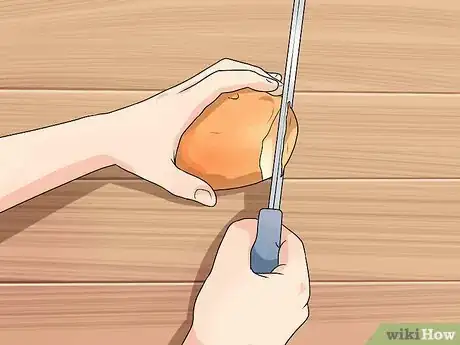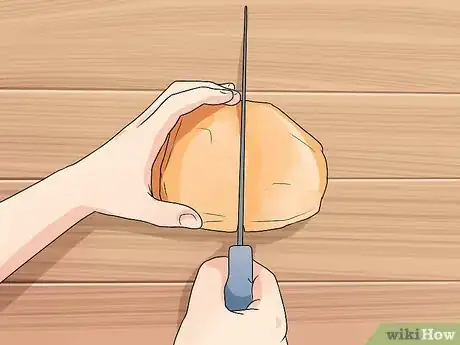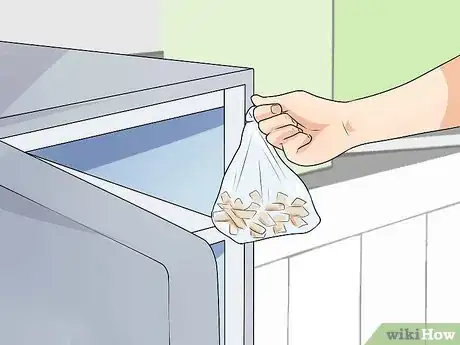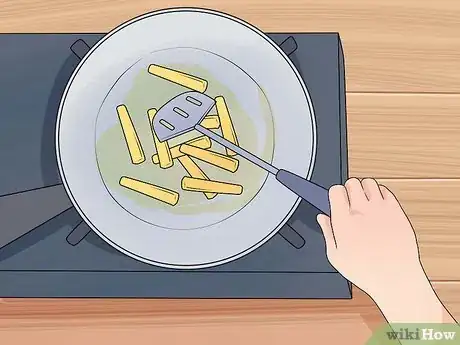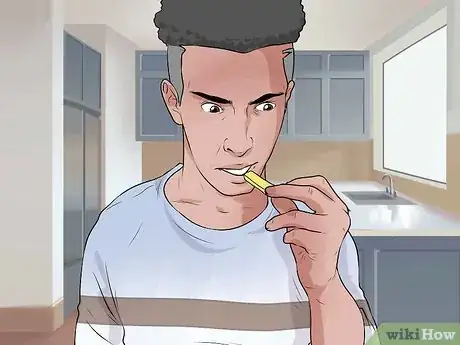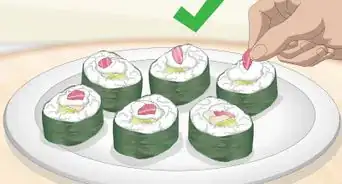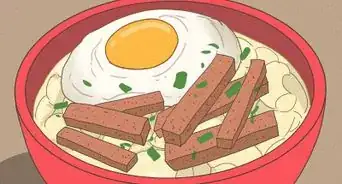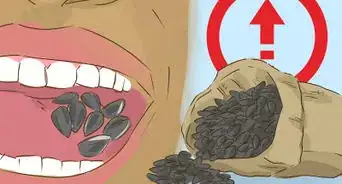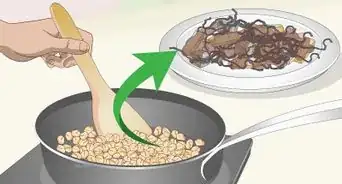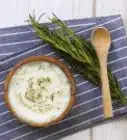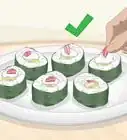This article was co-authored by Randall Chambers. Randall (Randy) Chambers is a Personal Chef and the Owner of Luxury Meals From Home based in Arvada, Colorado. He has more than 16 years of commercial kitchen experience, five years of sous chef experience, and two years of experience as an executive chef. Chef Randy draws inspiration from his half Bolivian background and his forte is South American cuisine. He holds an Associate’s degree in Culinary Arts from The Art Institute.
There are 7 references cited in this article, which can be found at the bottom of the page.
wikiHow marks an article as reader-approved once it receives enough positive feedback. This article received 23 testimonials and 100% of readers who voted found it helpful, earning it our reader-approved status.
This article has been viewed 281,215 times.
OK, you bought a jicama at the store and don't know what to do with it. This popular root vegetable can be eaten many different ways, and it's delicious, tasting something like a cross between an apple and a potato. Give it a try!
Steps
Preparing Jicama to Eat
-
1Find jicama. You may or may not find jicama at your local grocery store or farmer’s market -- it depends upon your location. General grocery stores are more likely to carry jicama in areas with sizable Hispanic or South Asian populations.
- If your local grocery store doesn't carry jicama, your best bet is specialty produce shops or Mexican, Asian, and Latin American grocery stores.
- You are most likely to find jicama in the spring and summer, as they are often imported from Central American countries at that time. Avoid tubers that are soft, shriveled, or have dark spots.
-
2Peel the jicama’s skin. You need to peel the skin of the jicama before you eat it. It might be hard to peel with a regular vegetable peeler. Do not eat the peel.
- Instead, try using a chef’s knife. First, cut a thin slice from both the top and the bottom to create a flat top and flat bottom on each end. Before you peel the jicama, though, wash it in cool running water and then dry it off like you would a potato.
- Set the jicama down on its broadest cut end. Work from top to bottom, and slide your knife beneath the jicama’s skin. Peel it while following the jicama’s natural lines.
Advertisement -
3Cut the jicama. After you peel the jicama, place it down on its widest cut end, and make even, vertical cuts in it. Then cut these pieces into sticks. Dice the sticks by cutting across them.[1] Dicing means you cut the jicama into small cubes.
- You can also shave the jicama on a mandolin slicer and roll them with fillings. First, cut the vegetable in half or in quarters, then use the mandolin to slice off thin shavings.[2]
Eating the Jicama
-
1Eat the jicama raw. You can eat jicama without cooking it. In fact, it tastes very good this way. You can eat it like a carrot stick, putting it in dip or just eating it plain.
- People also use jicama to make salsa, by mixing diced jicama with corn or diced tomato, black beans, red onion, minced jalapeño, lime juice, and cilantro.
- Turn the jicama into slaw by adding thin strips of it to shredded red cabbage and shredded carrots.
- Put jicama in spring rolls or stir fry it. Cooking it briefly will add a crunchy texture to your stir fry. You could cook it with broccoli, garlic, ginger, scallions, cashews or toasted sesame seeds.
-
2Saute the jicama. You can also saute the jicama with other vegetables, like broccoli, zucchini, onions, and sweet peppers. Jicama works well with other vegetables because it resembles the crunchy texture of water chestnuts.
- First, brown the jicama in a little bit of olive oil. Add a small sliced onion and ½ of a red pepper cut into strips. Cook until tender. [3]
- You can also roast jicama by cutting it into cubes and putting it in a baking pan. Preheat the oven to 400 degrees, sprinkle the jicama with olive oil, rosemary, parsley, and ½ teaspoon minced garlic, and roast it for an hour.
-
3Eat jicama chips. Jicama chips make a healthy snack. To make them, you should peel 1 pound of the jicama.
- Slice the jicama with a mandolin slicer to about 2 mm. Brush olive oil on both sides of the jicama slices, and add salt and pepper. Put the slices on parchment lined baking sheets. Make sure they are in single layers.
- Bake them at 200 degrees Fahrenheit for about 100 minutes. You will want to make sure they are crisp, and you should turn them every 20 minutes.
- You can also make raw jicama chips. Simply peel the jicama and thinly slice it. Squeeze one half of a lime onto the chips, and sprinkle them with salt, sugar, and chili powder. Chill for 20 minutes before serving.
-
4Make creative dishes with jicama. One way to eat jicama is to put it in fruit salad. This is common in Mexico, where street vendors will combine it with fruit.
- Mix diced jicama with chunks of mango, pineapple, watermelon, and cucumbers, and add lime juice and chili powder.[4]
- Add jicama to canapes for a cocktail party. Or use it instead of papayas in a shrimp salad. In a large bowl, mix jicama, sprouts, herbs and scallions. Whisk chili-garlic paste, lime juice, fish sauce and sugar, as well as salt and pepper. Mix together. Add shrimp and peanuts.[5]
- Consider adding jicama to salads, or use it to replace the cucumber in sushi rolls. It works best in quick-cooking recipes where it retains its crispness.[6]
Learning the Benefits of Jicama
-
1Get the facts on jicama. Jicama is a vegetable, not a fruit. This round, fleshy vegetable can grow to be quite large, and its skin has a bark-like texture.[7]
- The jicama’s taste has been described as similar to an apple. Sometimes called a Mexican turnip, jicama is a starchy, slightly sweet root vegetable popular in Mexico. It has the texture of a firm pear or raw potato.
- Jícama is a species in the genus Pachyrhizus in the bean family. Plants in this genus are referred to as yam bean, although that term can be another name for the jicama root itself. It grows in Central America, South Asia, and the Caribbean.[8]
-
2Know the health benefits of jicama. There are many reasons to eat jicama. For one, it has very few calories, only 35 per 100g. Jicama also is good for lowering cholesterol and has very low sodium.[9]
- It is a great source of dietary fiber. It is considered a good snack for people with diabetes, or people who are on diets. However, you should also know that jicama contains an organic toxin called rotenone that has been linked to Parkinson’s disease in some studies. The toxin is mostly found in the leaf tops, stems, and seed pods, so don't eat those. The peeled roots are considered safe for human consumption.
- Jicama is rich in vitamin C. Jicama also contains important minerals like magnesium, copper, iron, and manganese.[10]
Recipe Ideas
Community Q&A
-
QuestionHow do I know when it is ripe or if it is past its prime?
 Community AnswerI always look at its color. In my experience, a ripe one is a deep, green-ish golden color. The jicama is firm without any brown-ish indented areas. One that shows these defects is probably past its prime. If I am unsure about this, I ask the produce guy or girl. Also, in some of the large grocery stores, the produce departments have vegetable/fruit referral "books" available that will tell you what seasons they are available and what to look for.
Community AnswerI always look at its color. In my experience, a ripe one is a deep, green-ish golden color. The jicama is firm without any brown-ish indented areas. One that shows these defects is probably past its prime. If I am unsure about this, I ask the produce guy or girl. Also, in some of the large grocery stores, the produce departments have vegetable/fruit referral "books" available that will tell you what seasons they are available and what to look for. -
QuestionWhat would happen if I ate the skin?
 Community AnswerThe skin contains a toxic compound intended to stop animals from eating it. While probably not deadly, it would likely cause indigestion and other uncomfortable effects. Also, the skin is papery and fibrous, and not a pleasant texture for eating.
Community AnswerThe skin contains a toxic compound intended to stop animals from eating it. While probably not deadly, it would likely cause indigestion and other uncomfortable effects. Also, the skin is papery and fibrous, and not a pleasant texture for eating. -
QuestionCan it be kept in the freezer?
 Community AnswerNo, if you freeze it, it will lose its crunchiness once its thawed. But you can store it at room temperature for weeks if it's not peeled. If it is, then it will stay fresh in the fridge for about 3 - 5 days. Keep it in a sealed plastic bag.
Community AnswerNo, if you freeze it, it will lose its crunchiness once its thawed. But you can store it at room temperature for weeks if it's not peeled. If it is, then it will stay fresh in the fridge for about 3 - 5 days. Keep it in a sealed plastic bag.
Warnings
- Don't eat the skin.⧼thumbs_response⧽
- Always be careful with knives.⧼thumbs_response⧽
- Lime juice in the eye stings a whole bunch. Be careful.⧼thumbs_response⧽
Things You'll Need
- jicama
- knife
- cutting board
- limes
- salt
- chili powder
- an appetite for new things
References
- ↑ https://www.thekitchn.com/jicama-most-exciting-vegetable-youre-not-eating-the-vegetable-butcher-220006
- ↑ https://www.thekitchn.com/jicama-most-exciting-vegetable-youre-not-eating-the-vegetable-butcher-220006
- ↑ http://www.fruitsandveggiesmorematters.org/top-10-ways-to-enjoy-jicama
- ↑ http://www.smithsonianmag.com/arts-culture/five-ways-to-eat-jicama-77526473/?no-ist
- ↑ http://cooking.nytimes.com/recipes/10567-green-papaya-salad-with-shrimp
- ↑ http://www.cookinglight.com/cooking-101/essential-ingredients/jicama
- ↑ https://www.thekitchn.com/jicama-most-exciting-vegetable-youre-not-eating-the-vegetable-butcher-220006
- ↑ http://www.nutrition-and-you.com/jicama.html
- ↑ http://naturalsociety.com/7-benefits-of-the-root-vegetable-jicama/
About This Article
To eat a jicama, use a chef’s knife to peel the skin off, and then cut the remaining root into sticks. Once it is sliced, you can eat it raw and plain, or put it in dip, or stir fry it. If you want to sauté jicama, brown it in a little olive oil and then add a sliced onion and 1/2 of a red bell pepper. Cook until tender. You can also slice the jicama 2 mm thick to make jicama chips. Just brush the slices with olive oil, add salt and pepper, and bake them at 200°F for 100 minutes, turning frequently. For more cooking ideas and health information, keep reading!

